Enhancing the Catalytic Activity of Glycolate Oxidase from Chlamydomonas reinhardtii through Semi-Rational Design
Abstract
1. Introduction
2. Materials and Methods
2.1. Chemicals, Genes, Plasmids, and Strain
2.2. Expression of CreGO and GST
2.3. Fusion Expression of CreGO and GST
2.4. Homology Modeling and Molecular Docking
2.5. Site-Directed/Saturation Mutagenesis
2.6. Purification of GST-GSG-CreGO and Its Variants
2.7. Activity Assay and Determination of Kinetic Parameters
2.8. Expression of Catalase and Its Activity Determination
2.9. Oxidation of Methyl Glycolate to Methyl Glyoxylate
2.10. HPLC Analyses
3. Results and Discussion
3.1. Selection of Glycolate Oxidase
3.2. Improved Soluble Expression of CreGO
3.3. Homologous Modeling and Alanine Scanning of CreGO
3.4. Site-Saturation Mutagenesis of the Residue Y27 and Iterative Saturation Mutagenesis of the Residues V111 and V212
3.5. Purification and Characterization of GST-GSG-CreGO and Its Variant GST-GSG-CreGO-Y27S/V212R/V11G
3.6. Oxidation of Methyl Glycolate Catalyzed by Crude Enzymes GST-GSG-CreGO and GST-GSG-CreGO-Y27S/V212R/V111G
4. Conclusions
Supplementary Materials
Author Contributions
Funding
Data Availability Statement
Conflicts of Interest
References
- Bourhis, J.M.; Vignaud, C.; Pietrancosta, N.; Guéritte, F.; Guénard, D.; Lederer, F.; Lindqvist, Y. Structure of human glycolate oxidase in complex with the inhibitor 4-carboxy-5-[(4-chlorophenyl)sulfanyl]-1,2,3-thiadiazole. Acta Crystallogr. F 2009, 65, 1246–1253. [Google Scholar] [CrossRef]
- Dellero, Y.; Mauve, C.; Boex-Fontvieille, E.; Flesch, V.; Jossier, M.; Tcherkez, G.; Hodges, M. Experimental Evidence for a Hydride Transfer Mechanism in Plant Glycolate Oxidase Catalysis. J. Biol. Chem. 2015, 290, 1689–1698. [Google Scholar] [CrossRef]
- Dong, J.; Fernández-Fueyo, E.; Hollmann, F.; Paul, C.E.; Pesic, M.; Schmidt, S.; Wang, Y.; Younes, S.; Zhang, W. Biocatalytic Oxidation Reactions: A Chemist’s Perspective. Angew. Chem. Int. Ed. 2018, 57, 9238–9261. [Google Scholar] [CrossRef] [PubMed]
- Adam, W.; Lazarus, M.; Boss, B.; Saha-Möller, C.R.; Humpf, H.-U.; Schreier, P. Enzymatic Resolution of Chiral 2-Hydroxy Carboxylic Acids by Enantioselective Oxidation with Molecular Oxygen Catalyzed by the Glycolate Oxidase from Spinach (Spinacia oleracea). J. Org. Chem. 1997, 62, 7841–7843. [Google Scholar] [CrossRef]
- Brachais, C.H.; Huguet, J.; Bunel, C. Synthesis, characterization and stabilization of poly(methyl glyoxylate). Polymer 1997, 38, 4959–4964. [Google Scholar] [CrossRef]
- Zhu, H.; Pan, J.; Hu, B.; Yu, H.-L.; Xu, J.-H. Immobilization of glycolate oxidase from Medicago falcata on magnetic nanoparticles for application in biosynthesis of glyoxylic acid. J. Mol. Catal. B Enzym. 2009, 61, 174–179. [Google Scholar] [CrossRef]
- Heidlindemann, M.; Hammel, M.; Scheffler, U.; Mahrwald, R.; Hummel, W.; Berkessel, A.; Gröger, H. Chemoenzymatic Synthesis of Vitamin B5-Intermediate (R)-Pantolactone via Combined Asymmetric Organo- and Biocatalysis. J. Org. Chem. 2015, 80, 3387–3396. [Google Scholar] [CrossRef]
- Ying, X.; Wang, C.; Shao, S.; Wang, Q.; Zhou, X.; Bai, Y.; Chen, L.; Lu, C.; Zhao, M.; Wang, Z. Efficient Oxidation of Methyl Glycolate to Methyl Glyoxylate Using a Fusion Enzyme of Glycolate Oxidase, Catalase and Hemoglobin. Catalysts 2020, 10, 943. [Google Scholar] [CrossRef]
- Cederlund, E.; Lindqvist, Y.; SÖDerlund, G.; BrÄNdÉN, C.-I.; JÖRnvall, H. Primary structure of glycolate oxidase from spinach. Eur. J. Biochem. 1988, 173, 523–527. [Google Scholar] [CrossRef]
- Iwamoto, K.; Ikawa, T. A novel glycolate oxidase requiring flavin mononucleotide as the cofactor in the prasinophycean alga Mesostigma viride. Plant Cell Physiol. 2000, 41, 988–991. [Google Scholar] [CrossRef]
- Chauvin, L.; Tural, B.; Moroney, J.V. Chlamydomonas reinhardtii has Genes for Both Glycolate Oxidase and Glycolate Dehydrogenase. In Photosynthesis. Energy from the Sun; Allen, J.F., Gantt, E., Golbeck, J.H., Osmond, B., Eds.; Springer: Dordrecht, The Netherlands, 2008; pp. 823–827. [Google Scholar]
- Liu, Y.; Wu, W.; Chen, Z. Structures of glycolate oxidase from Nicotiana benthamiana reveal a conserved pH sensor affecting the binding of FMN. Biochem. Biophys. Res. Commun. 2018, 503, 3050–3056. [Google Scholar] [CrossRef]
- Rabhi-Essafi, I.; Sadok, A.; Khalaf, N.; Fathallah, D.M. A strategy for high-level expression of soluble and functional human interferon α as a GST-fusion protein in E. coli. Protein Eng. Des. Sel. 2007, 20, 201–209. [Google Scholar] [CrossRef]
- Arya, R.; Sabir, J.S.M.; Bora, R.S.; Saini, K.S. Optimization of culture parameters and novel strategies to improve protein solubility. Methods Mol. Biol. 2015, 1258, 45–63. [Google Scholar] [PubMed]
- Falak, S.; Sajed, M.; Rashid, N. Strategies to enhance soluble production of heterologous proteins in Escherichia coli. Biologia 2022, 77, 893–905. [Google Scholar] [CrossRef]
- Li, L.-K.; Shi, L.-L.; Hong, P.-H.; Tan, T.-W.; Li, Z.-J. Metabolic engineering of Escherichia coli for the production of glyoxylate from xylose. Biochem. Eng. J. 2018, 129, 113–118. [Google Scholar] [CrossRef]
- Reumann, S. Specification of the Peroxisome Targeting Signals Type 1 and Type 2 of Plant Peroxisomes by Bioinformatics Analyses. Plant Physiol. 2004, 135, 783–800. [Google Scholar] [CrossRef]
- Macheroux, P.; Mulrooney, S.B.; Williams, C.H.; Massey, V. Direct expression of active spinach glycolate oxidase in Escherichia coli. Biochim. Biophys. Acta Gene Struct. Expression 1992, 1132, 11–16. [Google Scholar] [CrossRef]
- Jin, J.-F.; Tan, T.-W.; Su, G.-F. The expression of spinach glycolate oxidase (GO) in E. coli and the application of GO in the production of glyoxylic acid. Mol. Biotechnol. 2003, 25, 207–214. [Google Scholar] [CrossRef]
- Sørensen, H.P.; Mortensen, K.K. Soluble expression of recombinant proteins in the cytoplasm of Escherichia coli. Microb. Cell Fact. 2005, 4, 1. [Google Scholar] [CrossRef]
- Weickert, M.J.; Doherty, D.H.; Best, E.A.; Olins, P.O. Optimization of heterologous protein production in Escherichia coli. Curr. Opin. Biotechnol. 1996, 7, 494–499. [Google Scholar] [CrossRef]
- Eche, S.; Gordon, M.L. Recombinant expression of HIV-1 protease using soluble fusion tags in Escherichia coli: A vital tool for functional characterization of HIV-1 protease. Virus Res. 2021, 295, 198289. [Google Scholar] [CrossRef] [PubMed]
- Zhu, F.Y.; Yang, Q.; Cao, M.; Zheng, K.; Zhang, X.J.; Shen, Q.; Cai, X.; Liu, Z.Q.; Zheng, Y.G. Tuning an efficient Escherichia coli whole-cell catalyst expressing L-pantolactone dehydrogenase for the biosynthesis of D-(-)-pantolactone. J. Biotechnol. 2023, 367, 1–10. [Google Scholar] [CrossRef] [PubMed]
- Lutz, S. Beyond directed evolution—Semi-rational protein engineering and design. Curr. Opin. Biotechnol. 2010, 21, 734–743. [Google Scholar] [CrossRef]
- Ebert, M.C.; Pelletier, J.N. Computational tools for enzyme improvement: Why everyone can—And should—Use them. Curr. Opin. Chem. Biol. 2017, 37, 89–96. [Google Scholar] [CrossRef] [PubMed]
- Yu, H.; Qiu, S.; Cheng, F.; Cheng, Y.-N.; Wang, Y.-J.; Zheng, Y.-G. Improving the catalytic efficiency of aldo-keto reductase KmAKR towards t-butyl 6-cyano-(3R,5R)-dihydroxyhexanoate via semi-rational design. Bioorg. Chem. 2019, 90, 103018. [Google Scholar] [CrossRef]
- Xiong, W.; Liu, B.; Shen, Y.; Jing, K.; Savage, T.R. Protein engineering design from directed evolution to de novo synthesis. Biochem. Eng. J. 2021, 174, 108096. [Google Scholar] [CrossRef]
- Wahart, A.J.C.; Staniland, J.; Miller, G.J.; Cosgrove, S.C. Oxidase enzymes as sustainable oxidation catalysts. R. Soc. Open Sci. 2022, 9, 211572. [Google Scholar] [CrossRef]
- Volokita, M.; Somerville, C.R. The primary structure of spinach glycolate oxidase deduced from the DNA sequence of a cDNA clone. J. Biol. Chem. 1987, 262, 15825–15828. [Google Scholar] [CrossRef]
- Stenberg, K.; Clausen, T.; Lindqvist, Y.; Macheroux, P. Involvement of Tyr24 and Trp108 in Substrate Binding and Substrate Specificity of Glycolate Oxidase. Eur. J. Biochem. 1995, 228, 408–416. [Google Scholar] [CrossRef]
- Murray, M.S.; Holmes, R.P.; Lowther, W.T. Active Site and Loop 4 Movements within Human Glycolate Oxidase: Implications for Substrate Specificity and Drug Design. Biochemistry 2008, 47, 2439–2449. [Google Scholar] [CrossRef]
- Shapiro, A.L.; Vinuela, E.; Maizel, J.V., Jr. Molecular weight estimation of polypeptide chains by electrophoresis in SDS-polyacrylamide gels. Biochem. Biophys. Res. Commun. 1967, 28, 815–820. [Google Scholar] [CrossRef]
- Waterhouse, A.; Bertoni, M.; Bienert, S.; Studer, G.; Tauriello, G.; Gumienny, R.; Heer, F.T.; de Beer, T.A.P.; Rempfer, C.; Bordoli, L.; et al. SWISS-MODEL: Homology modelling of protein structures and complexes. Nucleic Acids Res. 2018, 46, W296–W303. [Google Scholar] [CrossRef]
- Trott, O.; Olson, A.J. AutoDock Vina: Improving the speed and accuracy of docking with a new scoring function, efficient optimization, and multithreading. J. Comput. Chem. 2010, 31, 455–461. [Google Scholar] [CrossRef] [PubMed]
- Smith, P.K.; Krohn, R.I.; Hermanson, G.T.; Mallia, A.K.; Gartner, F.H.; Provenzano, M.D.; Fujimoto, E.K.; Goeke, N.M.; Olson, B.J.; Klenk, D.C. Measurement of protein using bicinchoninic acid. Anal. Biochem. 1985, 150, 76–85. [Google Scholar] [CrossRef] [PubMed]
- Hackenberg, C.; Kern, R.; Hüge, J.; Stal, L.J.; Tsuji, Y.; Kopka, J.; Shiraiwa, Y.; Bauwe, H.; Hagemann, M. Cyanobacterial lactate oxidases serve as essential partners in N2 fixation and evolved into photorespiratory glycolate oxidases in plants. Plant Cell 2011, 23, 2978–2990. [Google Scholar] [CrossRef] [PubMed]
- Lindqvist, Y.; Brändén, C. The active site of spinach glycolate oxidase. J. Biol. Chem. 1989, 264, 3624–3628. [Google Scholar] [CrossRef] [PubMed]
- Zhang, B.; Du, H.; Zheng, Y.; Sun, J.; Shen, Y.; Lin, J.; Wei, D. Design and engineering of whole-cell biocatalyst for efficient synthesis of (R)-citronellal. Microb. Biotechnol. 2021, 43, 51–60. [Google Scholar] [CrossRef]
- Morrison, K.L.; Weiss, G.A. Combinatorial alanine-scanning. Curr. Opin. Chem. Biol. 2001, 5, 302–307. [Google Scholar] [CrossRef]
- Isobe, K.; Nishise, H. A method for glyoxylic acid production using cells of Alcaligenes sp. GOX373. J. Biotechnol. 1999, 75, 265–271. [Google Scholar] [CrossRef]
- Isobe, K.; Watabe, S.; Yamada, M. Characterization and application of a glycolate dehydrogenase from Trichoderma harzianum AIU 353. J. Mol. Catal. B Enzym. 2012, 83, 94–99. [Google Scholar] [CrossRef]
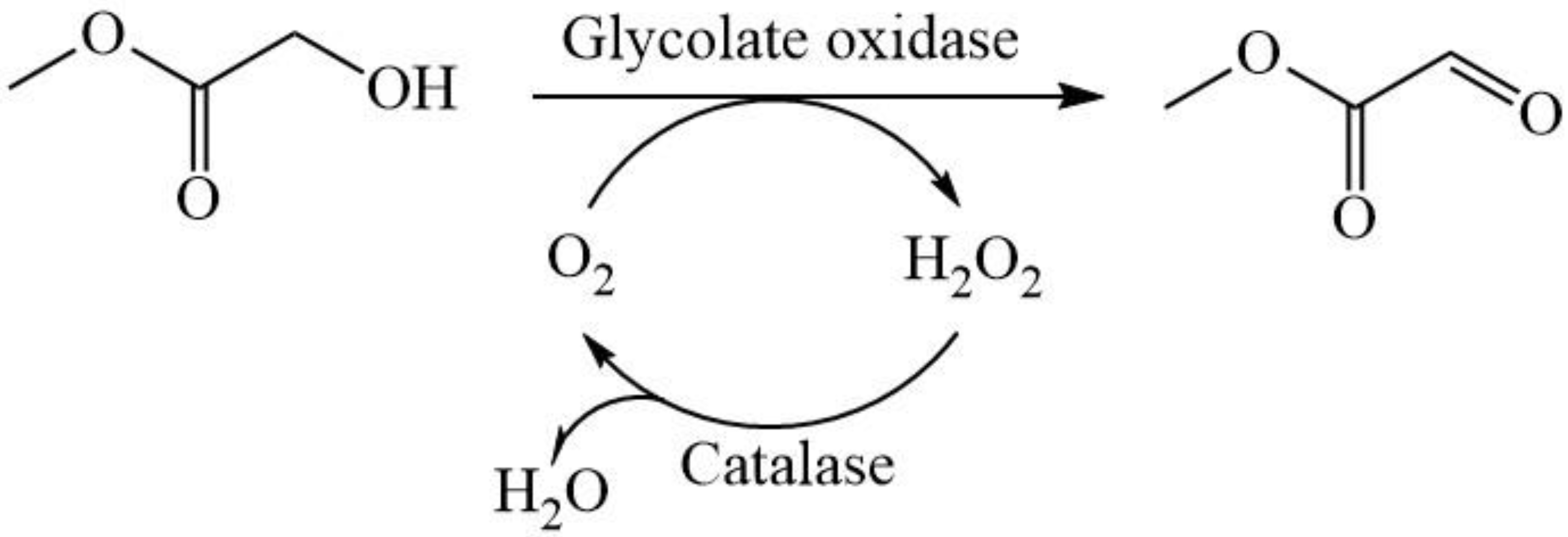
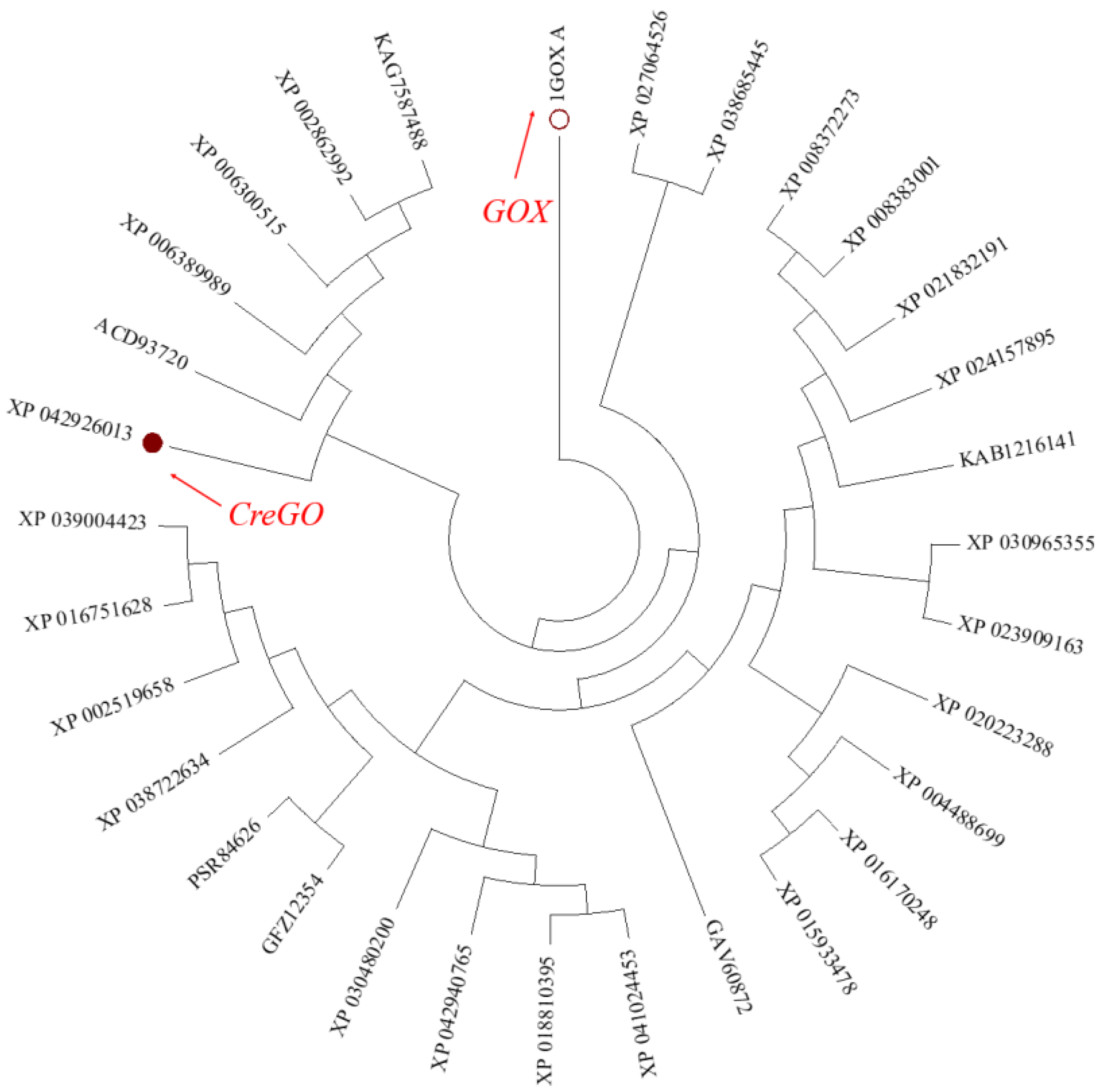
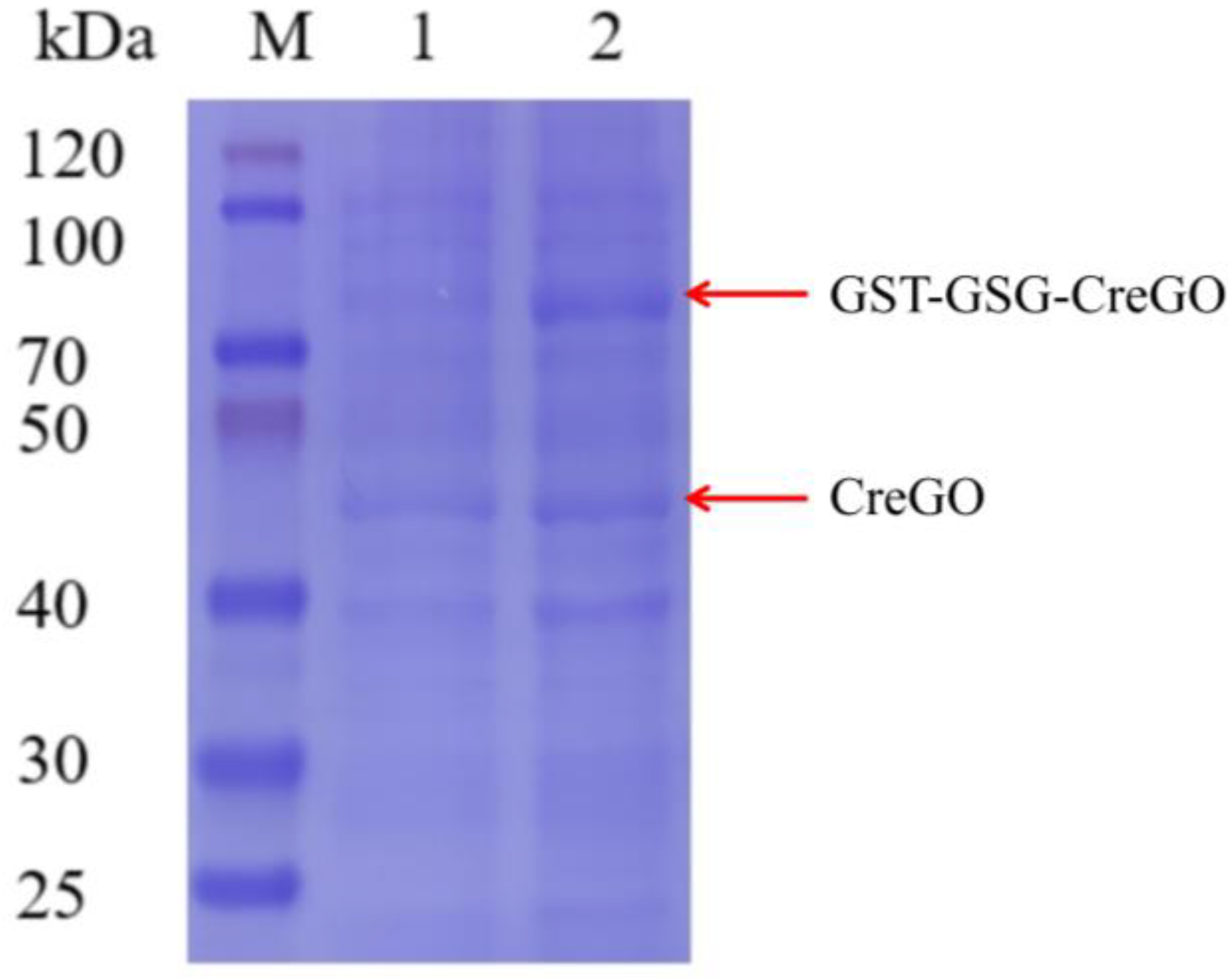

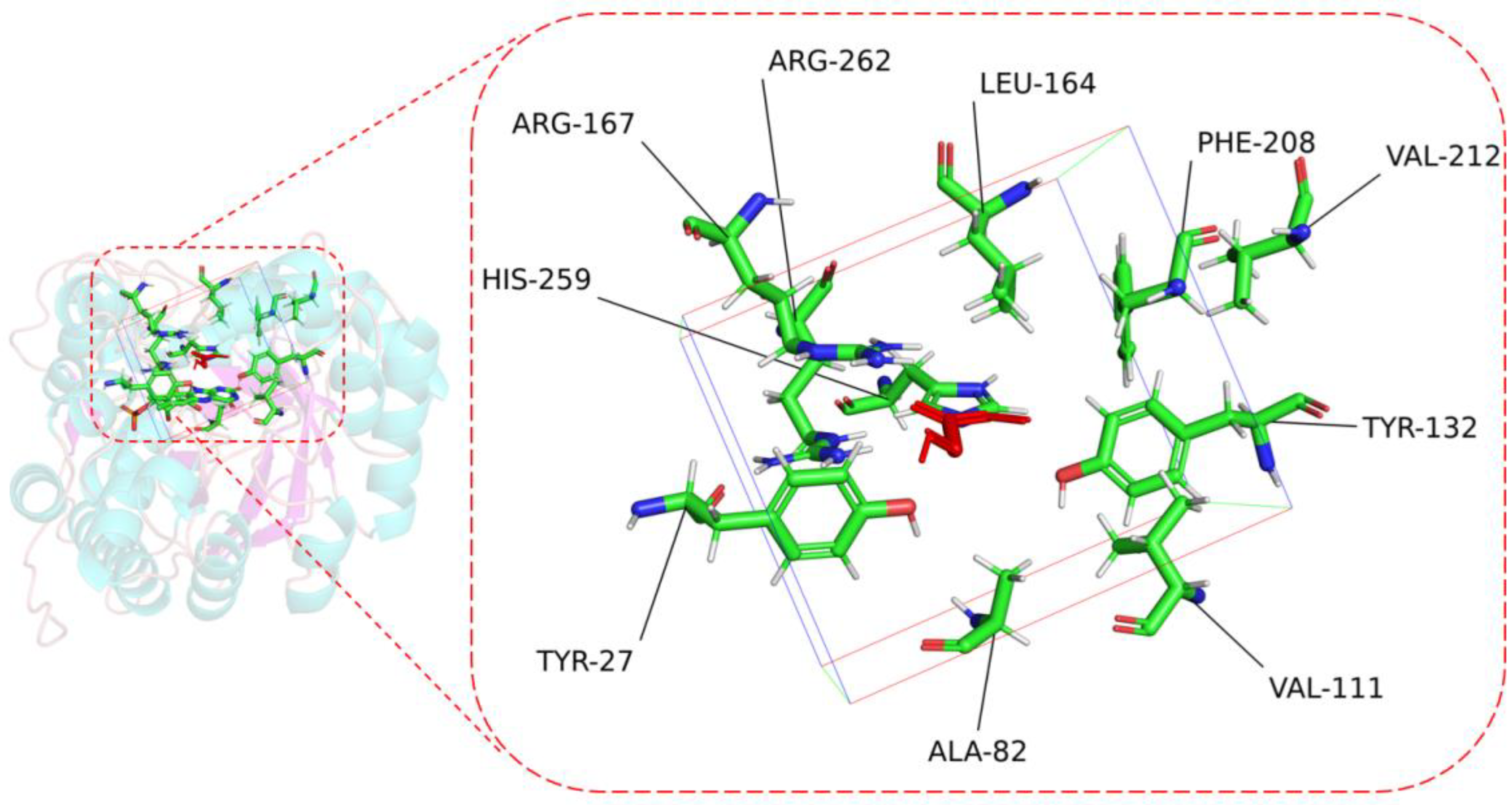
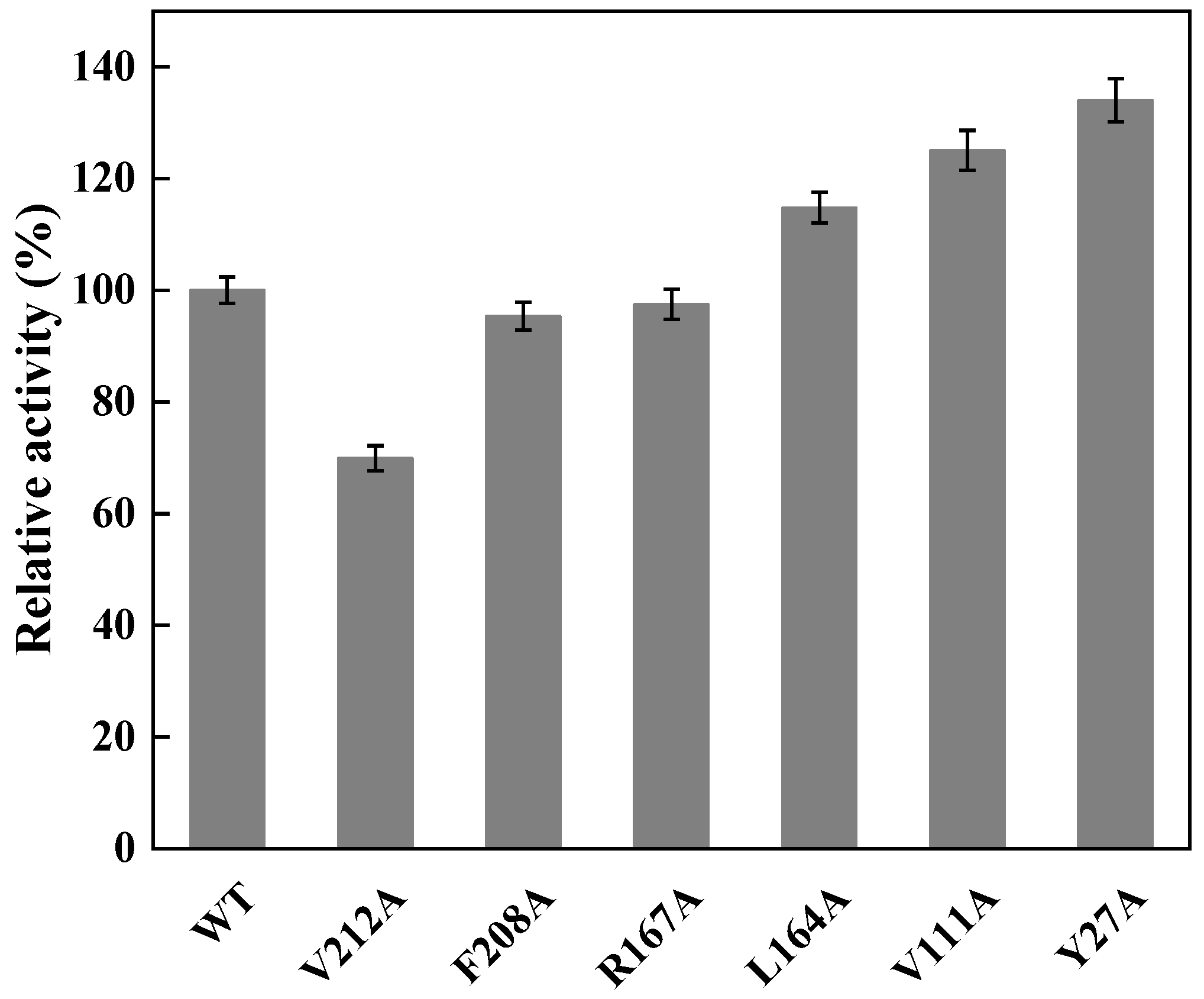
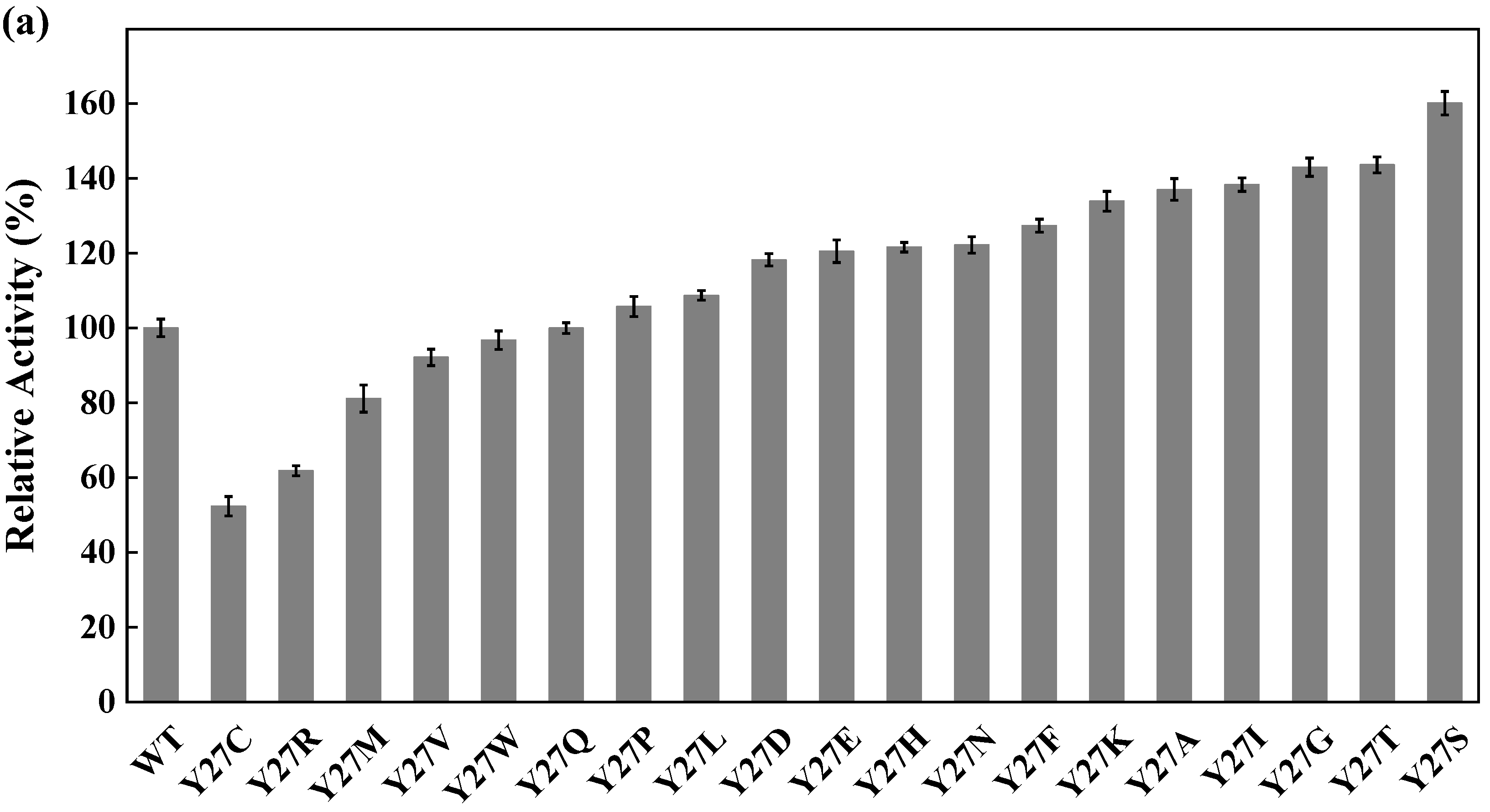
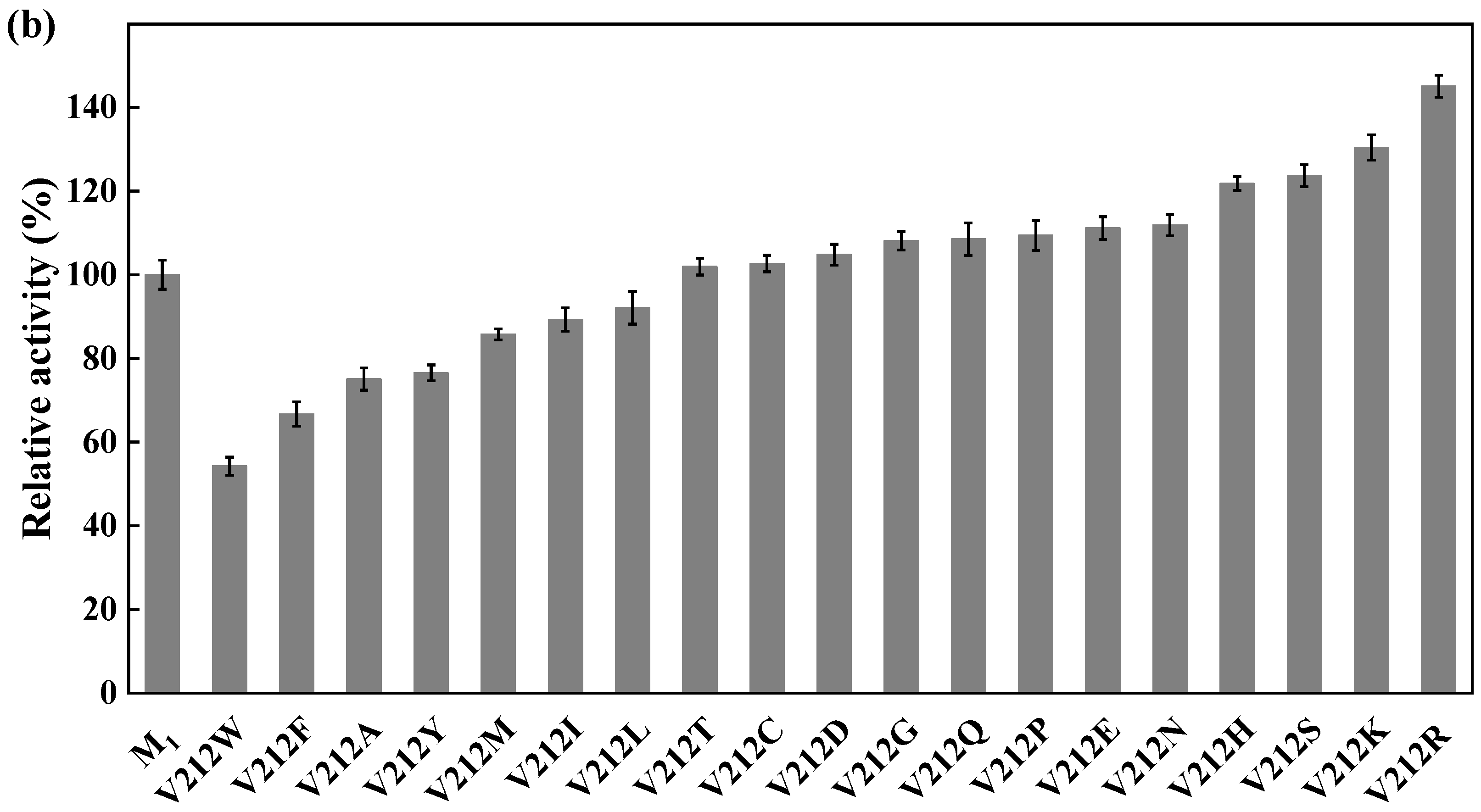
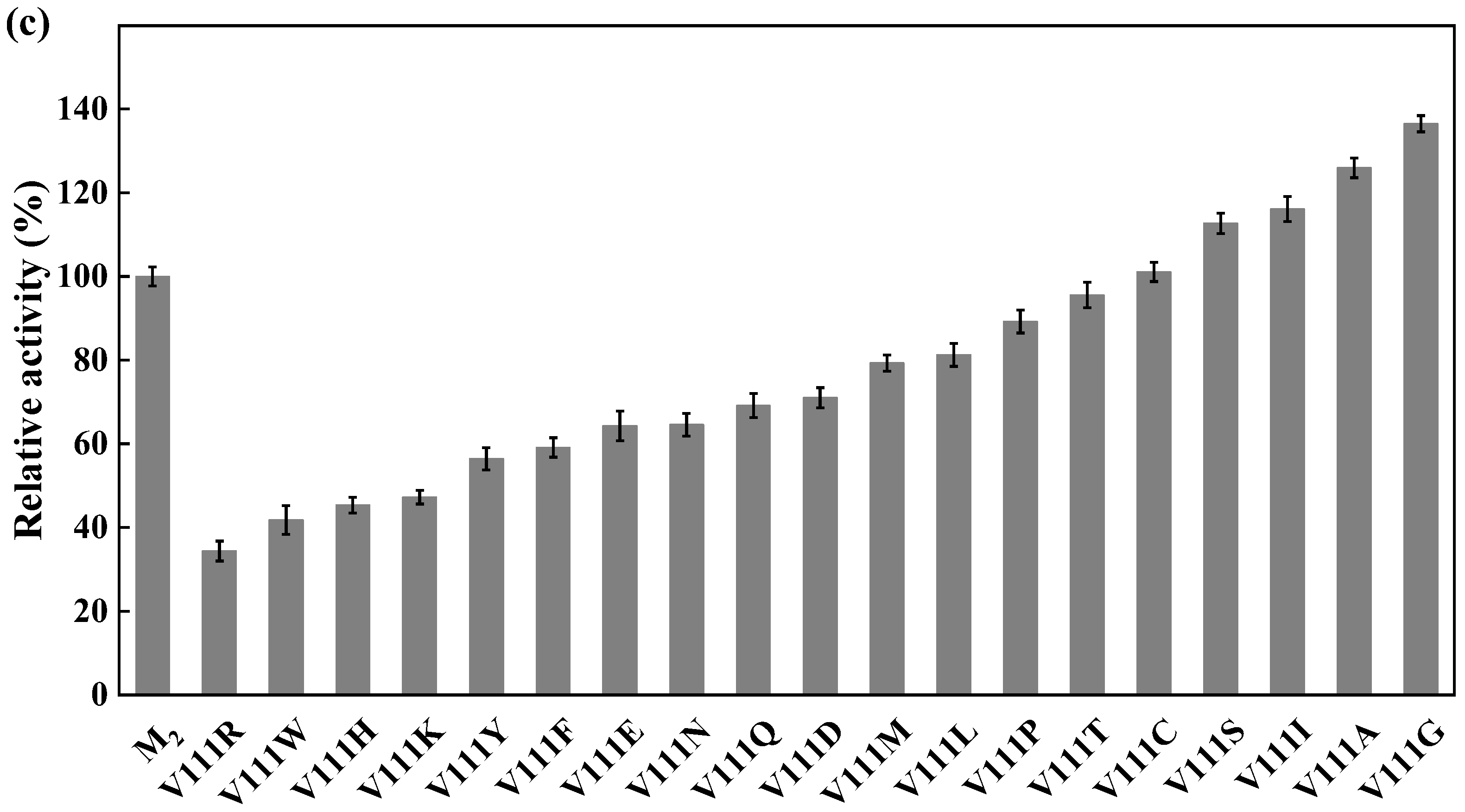
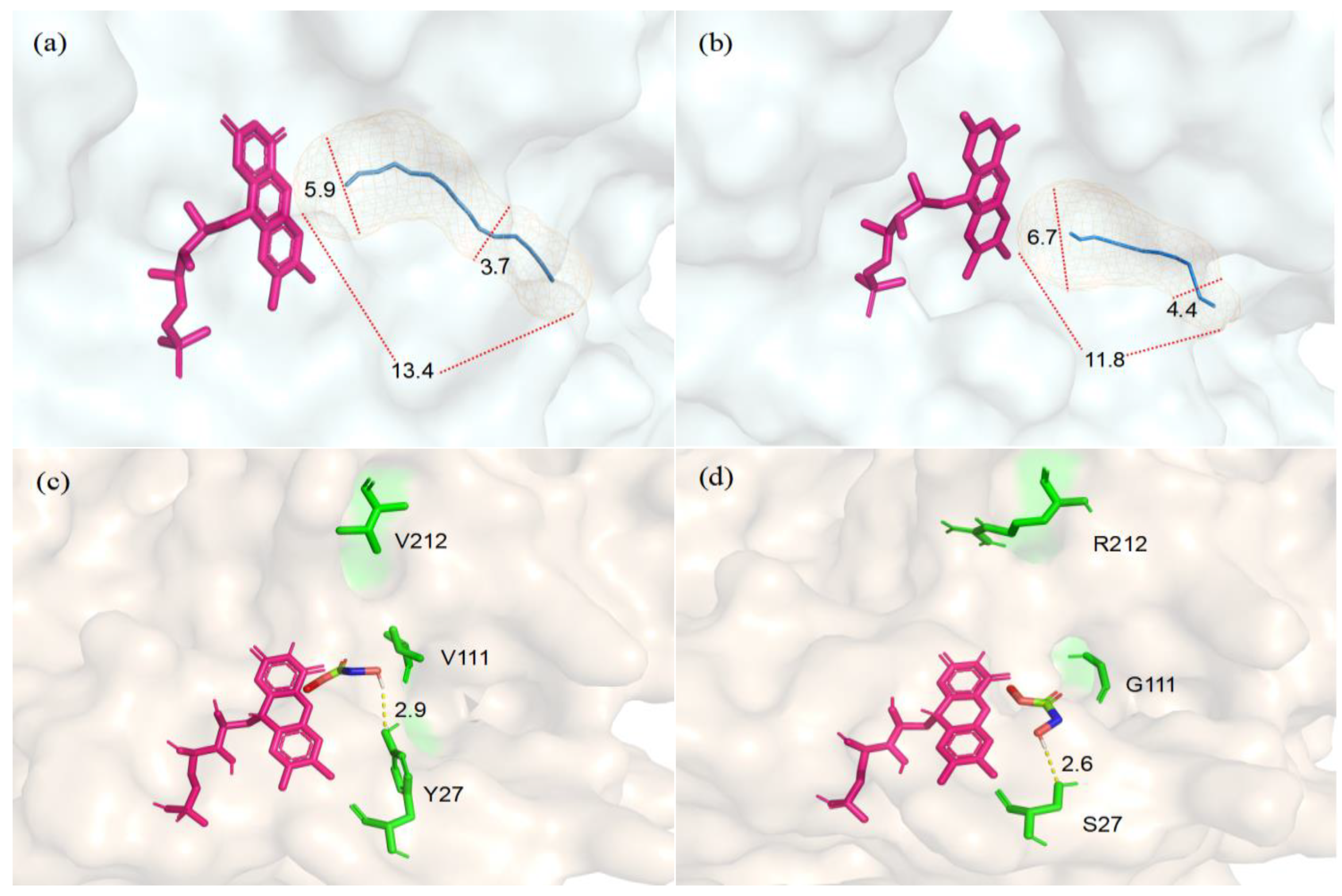
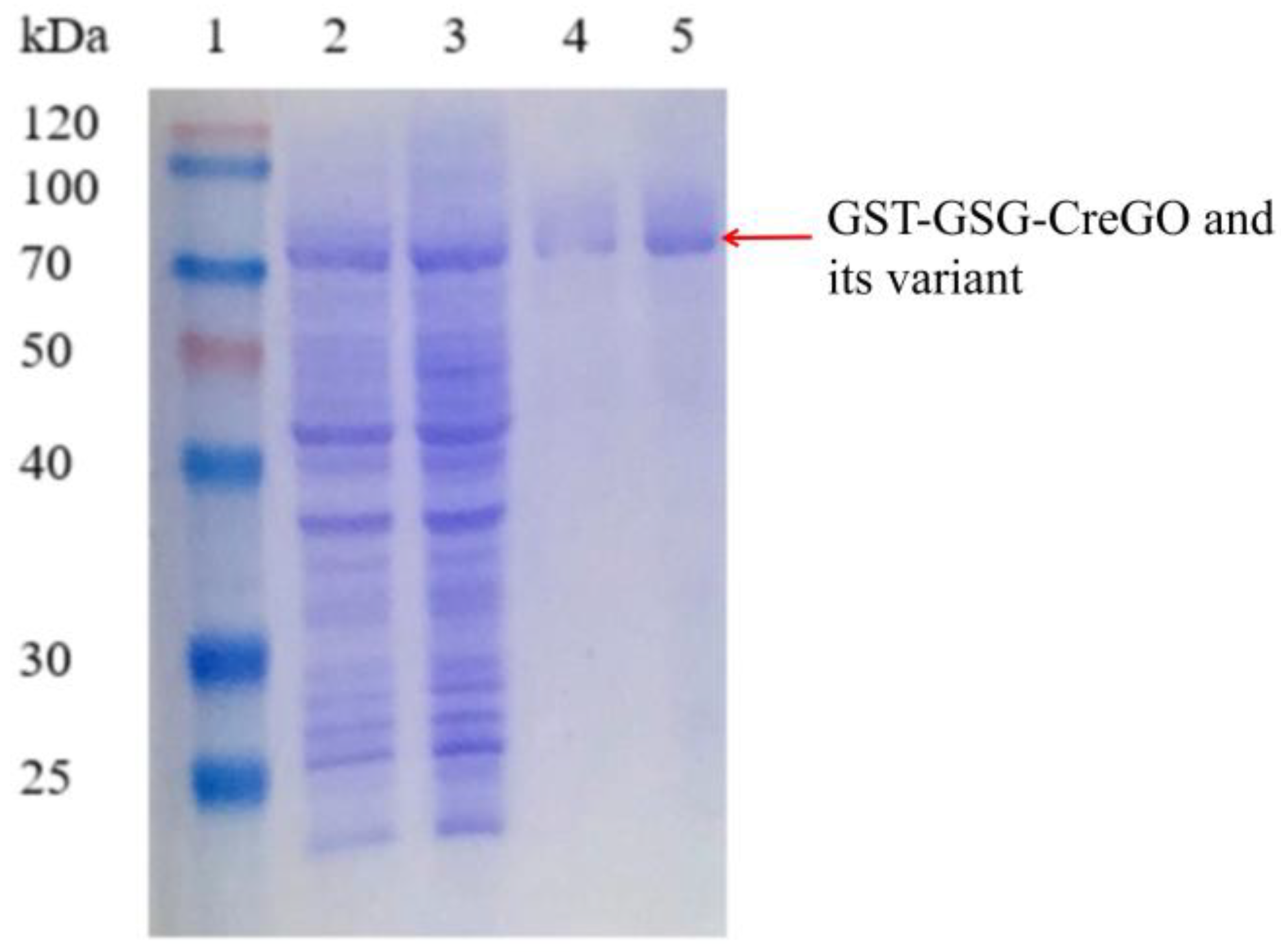
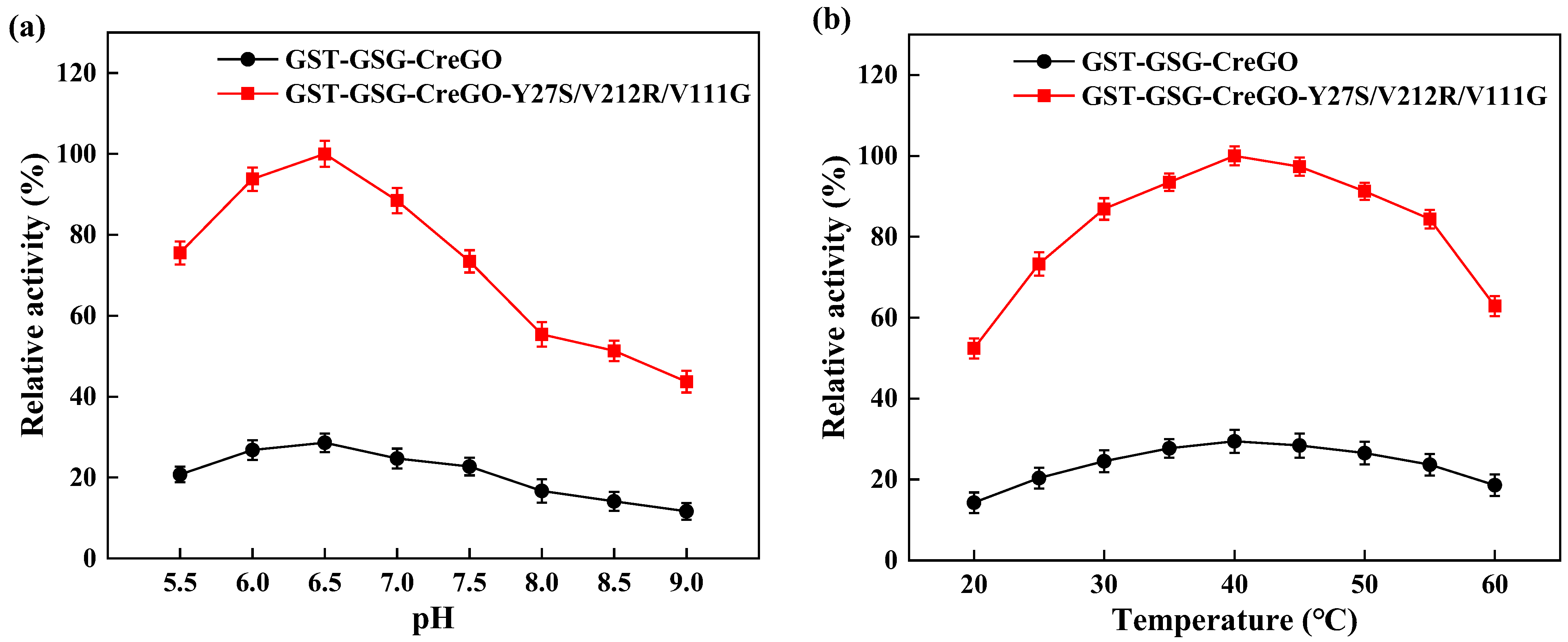
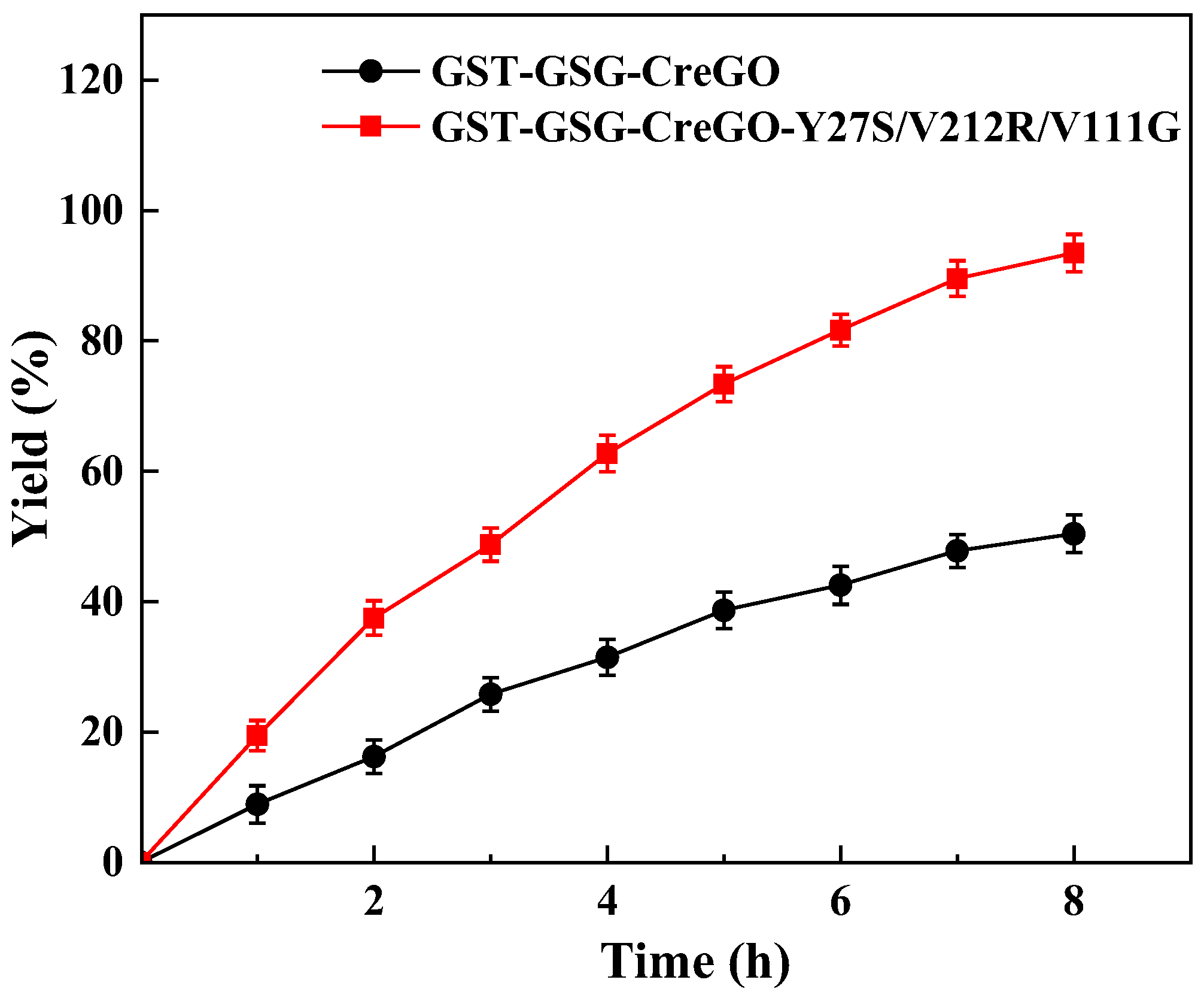
| Parameters | GST-GSG-CreGO | GST-GSG-CreGO-Y27S/V212R/V111G |
|---|---|---|
| Vmax (U/mg) | 7.2 ± 0.2 | 25.5 ± 0.9 |
| Km (mM) | 1.0 ± 0.05 | 0.6 ± 0.04 |
| kcat (s−1) | 4.9 ± 0.2 | 17.5 ± 0.6 |
| kcat/Km (s−1·mM−1) | 4.9 ± 0.2 | 29.2 ± 1.0 |
Disclaimer/Publisher’s Note: The statements, opinions and data contained in all publications are solely those of the individual author(s) and contributor(s) and not of MDPI and/or the editor(s). MDPI and/or the editor(s) disclaim responsibility for any injury to people or property resulting from any ideas, methods, instructions or products referred to in the content. |
© 2023 by the authors. Licensee MDPI, Basel, Switzerland. This article is an open access article distributed under the terms and conditions of the Creative Commons Attribution (CC BY) license (https://creativecommons.org/licenses/by/4.0/).
Share and Cite
Feng, Y.; Shao, S.; Zhou, X.; Wei, W.; Liu, X.; Tang, Y.; Hua, Y.; Zheng, J.; Zhang, Y.; Ying, X. Enhancing the Catalytic Activity of Glycolate Oxidase from Chlamydomonas reinhardtii through Semi-Rational Design. Microorganisms 2023, 11, 1689. https://doi.org/10.3390/microorganisms11071689
Feng Y, Shao S, Zhou X, Wei W, Liu X, Tang Y, Hua Y, Zheng J, Zhang Y, Ying X. Enhancing the Catalytic Activity of Glycolate Oxidase from Chlamydomonas reinhardtii through Semi-Rational Design. Microorganisms. 2023; 11(7):1689. https://doi.org/10.3390/microorganisms11071689
Chicago/Turabian StyleFeng, Yingting, Shuai Shao, Xueting Zhou, Wan Wei, Xun Liu, Yi Tang, Yuhao Hua, Jianyong Zheng, Yinjun Zhang, and Xiangxian Ying. 2023. "Enhancing the Catalytic Activity of Glycolate Oxidase from Chlamydomonas reinhardtii through Semi-Rational Design" Microorganisms 11, no. 7: 1689. https://doi.org/10.3390/microorganisms11071689
APA StyleFeng, Y., Shao, S., Zhou, X., Wei, W., Liu, X., Tang, Y., Hua, Y., Zheng, J., Zhang, Y., & Ying, X. (2023). Enhancing the Catalytic Activity of Glycolate Oxidase from Chlamydomonas reinhardtii through Semi-Rational Design. Microorganisms, 11(7), 1689. https://doi.org/10.3390/microorganisms11071689






